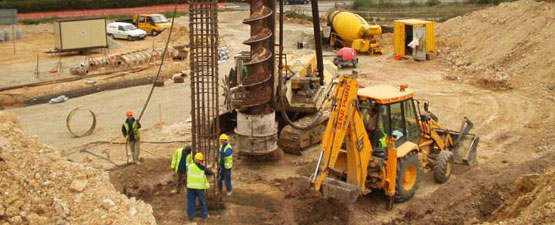Some Known Questions About Geotheta.
Wiki Article
Geotheta Can Be Fun For Everyone
Table of ContentsUnknown Facts About GeothetaSome Known Facts About Geotheta.What Does Geotheta Do?Things about GeothetaThe Of Geotheta

They carry out site investigations, collect examples, execute research laboratory examinations, and analyze information to assess the suitability of the ground for building projects - Tailings Engineer. Based upon their searchings for, geotechnical engineers provide suggestions for foundation layout, incline stability, preserving structures, and mitigation of geotechnical hazards. They work together with other professionals, such as designers, architectural designers, and building teams, to make sure that geotechnical factors to consider are integrated right into the overall project layout and execution
By assessing the habits and properties of dirt and rock, they can identify possible geotechnical threats such as landslides, dirt settlement, or slope instability. Their expertise assists avoid failings or mishaps that might jeopardize lives and home. Below are some in-depth tasks and duties of a geotechnical engineer: Website Examination: Geotechnical engineers conduct website investigations to gather data on subsurface problems.
They translate the information to comprehend the properties and habits of the dirt and rock, including their toughness, permeability, compaction features, and groundwater problems. Geotechnical Evaluation and Layout: Geotechnical engineers evaluate the information gathered during site examinations to examine the stability and suitability of the website for building and construction projects. They carry out geotechnical estimations and modeling to evaluate elements such as bearing capability, settlement, slope security, side planet stress, and groundwater flow.
The 9-Second Trick For Geotheta
Foundation Design: Geotechnical designers play a vital duty in making structures that can securely sustain the desired structure. They examine the soil conditions and tons needs to figure out the ideal foundation kind, such as superficial structures (e.g., footings), deep structures (e.g (https://telegra.ph/Why-Geotheta-is-Your-Go-To-for-Geotechnical-Engineers-in-South-Africa-08-02)., piles), or specialized techniques like dirt improvement. They take into consideration elements such as settlement limits, birthing capability, and soil-structure interaction to develop optimal structure layoutsThey review building and construction strategies, screen site tasks, and carry out field assessments to confirm that the design referrals are adhered to. If unpredicted geotechnical issues emerge, they analyze the circumstance and give referrals for remediation or adjustments to the style. Risk Evaluation and Reduction: Geotechnical engineers assess geotechnical dangers and risks connected with the task site, such as landslides, liquefaction, or dirt erosion.

Collaboration and Interaction: Geotechnical designers work very closely with various other professionals associated with a project, such as architects, architectural engineers, and building and construction teams. Efficient communication and cooperation are vital to integrate geotechnical considerations into the general task design and construction procedure. Geotechnical designers supply technical expertise, solution questions, and guarantee that geotechnical requirements are fulfilled.
Fascination About Geotheta
Here are some kinds of geotechnical designers: Structure Engineer: Foundation designers focus on developing and evaluating foundations for structures. They evaluate the dirt conditions, lots needs, and website characteristics to identify the most proper foundation type and style, such as shallow structures, deep structures, or specialized strategies like heap structures.They examine the variables affecting slope security, such as soil properties, groundwater problems, and incline geometry, and develop strategies to prevent slope failures and minimize threats. Earthquake Designer: Earthquake designers focus on examining and designing frameworks to withstand seismic pressures. They assess the seismic hazard of a website, examine dirt liquefaction potential, and create seismic style criteria to ensure the safety and strength of frameworks during earthquakes.
They execute area screening, accumulate examples, and examine the collected information to identify the dirt residential properties, geologic formations, and groundwater conditions at a site. Geotechnical Instrumentation Engineer: Geotechnical instrumentation designers concentrate on monitoring and gauging the habits of soil, rock, and frameworks. They install and preserve instrumentation systems that monitor factors such as dirt settlement, groundwater degrees, slope activities, and architectural variations to evaluate efficiency and offer very early warnings of possible concerns.
Some Of Geotheta
They conduct examinations such as triaxial tests, consolidation examinations, direct shear examinations, and leaks in the structure tests to collect information for geotechnical analysis and style. Geosynthetics Engineer: Geosynthetics engineers focus on the layout and application of geosynthetic materials, such as geotextiles, geogrids, and geomembranes. They utilize these products to improve soil stability, reinforce slopes, supply water drainage solutions, and control erosion.They have a tendency to be investigatory people, which suggests they're intellectual, introspective, and curious. They wonder, systematic, sensible, logical, and logical. A few of them are likewise social, implying they're kind, generous, cooperative, client, caring, useful, understanding, sensible, and pleasant. Does this noise like you? Take our cost-free career examination to discover if geotechnical designer is one of your leading career matches.
In the office atmosphere, geotechnical designers make use of specialized software program tools to carry out computations, create layouts, and evaluate information. They prepare reports, review job specs, interact with customers and employee, and coordinate project activities. The office setting offers a helpful atmosphere for research, evaluation, and partnership with various other specialists associated with the project.
The Of Geotheta
They frequently check out project sites to carry out website investigations, analyze geotechnical conditions, and collect information for analysis. These brows through involve traveling to various places, occasionally in remote or difficult surfaces. Geotechnical designers may execute soil tasting, conduct examinations, and display construction tasks to ensure that the geotechnical elements of the task are being applied correctly.Geotechnical designers additionally work in specialized geotechnical labs. In these centers, they carry out experiments, execute tests on dirt and rock examples, and analyze the design buildings of the products. Geotechnical laboratory designers function thoroughly in these settings, taking care of testing tools, operating instruments, and videotaping information. They collaborate with various other research laboratory personnel to make certain precise and reliable testing outcomes.
Report this wiki page